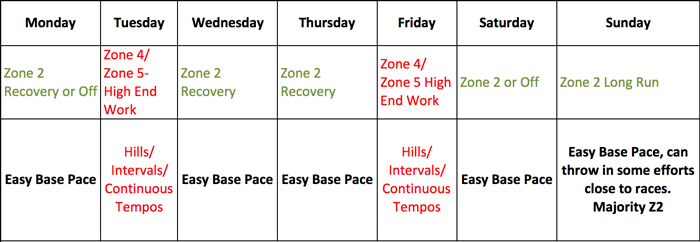Do you find yourself validating a good run with an average pace? Have to catch that runner up ahead of you on the path, so you drop the pace and push a little harder? Desperate to break the four-hour marathon barrier or to get yourself under 1:30 in the half? Do you find that even though you’re pushing yourself harder and harder, you don’t see the results in races? The truth is that you’re likely in a Zone 3 plateau, which means you’re probably pushing too hard too often and not running slow enough often enough. It doesn’t matter your pace, slowing down to go faster is the real deal.
Training in the Right Running Zones
For runners, there is little better for you than slow Zone 2 base running. Many runners push Zone 2 work out of the way in favor of Zone 3 work because they fall into the trap that running harder more often will lead to better results. However, Zone 3 work is above aerobic pace and has some lactate response, which means that it isn’t hard enough to elicit a desirable physical adaptation, and yet it’s too hard to allow for day-to-day recovery.
Constantly pushing in Zone 3 day after day is a habit of the time-crunched runner, where mileage and average pace is the only validator of training. This athlete can often find themselves in a rut and left wondering how they could work so hard for so little results. As mentioned above, continual Zone 3 work doesn’t allow for enough recovery and puts the athlete in a state of continuous fatigue. No wonder we call it feeling “hammered out!” So how can we get out of the rut and back to PRs?
Stick to Your Running Heart Rate Zones
The first rule is that you want to keep your easy days truly easy and your hard days hard. An easy hour in Zone 2 will always provide a better benefit than a moderately hard Zone 3 effort for that same hour. You want to create a schedule that allows you to run easy days in Zone 2 to illicit a recovery response, increase aerobic capacity, and increase fatty acid usage. The latter is a major benefit of Zone 2 running, true aerobic running will make you a better fat burner. Zone 3 running will leave you burning a mixture of carbs and fat, never making you super efficient at being a carb burner or fat burner!

Simply put, your hard days should be hard! With a high heart rate in Zone 4/ Zone 5 for increasingly longer periods (in accordance with your race goals). There is no major benefit to be gained from Zone 3 when you could be doing high-end Zone 4 and Zone 5 (Threshold/ VO2 Max). The benefits for speed, lactate endurance and metabolism are maximized when you’re doing top-end Zone 4 and Zone 5 work. This is where you become efficient at mitigating lactic acid, more efficient at burning carbs, and thereby reach your optimal performance.
Creating the Perfect Running Training Plan
So what’s the time-crunched athlete to do? How do you create a schedule that allows us to capture the benefits of spectrum running? What else can I do to help break through?
The first thing an athlete adopting this methodology needs to do is to throw away their “average pace” ego. Validating a run on average pace alone is a dangerous proposition, leading you directly into a hard run at the cost of recovery and adaptation. The two best things you can do are to invest in a heart rate monitor and calculate your pace zones based on a recent race effort.
Every hard day should be followed by one or two days of easy running. For example:

This schedule allows for adequate recovery, maximizes time, and allows even the time-crunched athlete to get in two high-quality workouts a week. A majority of athletes will see a big jump in fitness when they slow down and put the energy they saved on Zone 2 days into the hard Zone 4/ Zone 5 days.
You can determine your increase in fitness by doing periodic fitness tests on your hard days to see if you are increasing. You can also determine the right number of Zone 2 recovery days by finding your resting HR and checking it in the morning to see if you’re recovered enough to do high-end work. This method is called heart rate variability (HRV)training, and it can be very helpful for preventing overtraining.
Run Slower to Get Faster
If you’re desperate to break through and you’re pushing yourself to the brink run after run, try taking a “run slower to get faster” approach to your running. Your mileage may be lower at first, but the aerobic benefit you’ll receive will outweigh the loss in mileage. Try utilizing the methods and schedule above to structure your training to see success at your next major race. Most athletes see a jump in fitness after four weeks and the biggest jumps between four and 12 weeks.
If this seems like a lot of work, TrainingPeaks has a number of amazing coaches that you can get matched with who can help you reach your goals faster than you thought possible! To find a coach that’s a good fit for you, check out the TrainingPeaks Coach Match Service.









